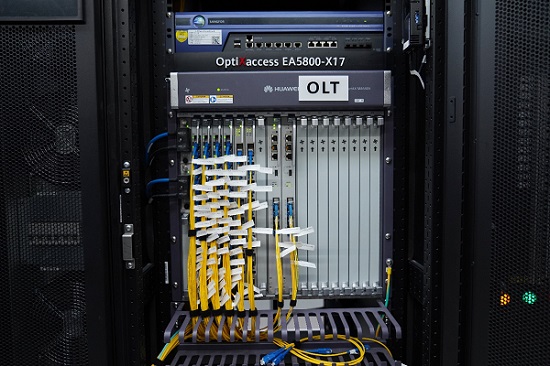Huawei Campus OptiX Solution Helps Realize a Superior Medical Experience for Union Shenzhen Hospital
This site uses cookies. By continuing to browse the site you are agreeing to our use of cookies. Read our privacy policy>
![]()
Enterprise products, solutions & services
Huazhong University of Science and Technology Union Shenzhen Hospital — simply Union Shenzhen Hospital for short — is a highly-rated hospital located in Shenzhen's southwestern Nanshan District. The hospital's patient-centric approach harnesses clear, comprehensive, and rapid diagnostic and treatment data — gained through cutting-edge Information and Communications Technology (ICT) — to assist medical diagnoses, doctor-patient communication, and medical teaching. It really couldn't be any clearer: having already built the first all-optical hospital in China's Guangdong Province, Union Shenzhen Hospital is wholly committed to ICT construction and the benefits it brings.
To improve the quality of healthcare services, the hospitals of today are deploying digital signage systems, video backhaul in public areas, data backhaul from medical devices, and digital ward calling systems. If these networks — distributed across offices, diagnosis and treatment rooms, examination rooms, conference rooms, and wards — are independently deployed, cabling and construction presents a significant challenge, with management and potential upgrades also extremely complex.
Besides, a traditional switching network is limited by the 100 m transmission distance of network cables. This means that networks in the outpatient and inpatient departments need to be converged, layer by layer, occupying a large number of Information Technology (IT) Extra Low Voltage (ELV) rooms as a result, as well as requiring excessive cabling. And of course, equipment and air conditioners in such ELV rooms all also require power, pushing up operating costs.
With more functional areas likely to be used in hospitals in the future, network expansion is also inevitable. Terminals and medical devices, for example, are likely to be added to consultation rooms and offices, necessitating complex re-cabling and reconstruction of traditional networks. This often involves removing ceilings and heavy construction work, contaminating the air with dust particles: hardly conducive to patient health and an irritant for hospital staff. The operation of sensitive medical equipment can also be disrupted.
Nonetheless, hospital staff still want — need — fast networks with low latency for real-time access to treatment information and high-definition medical images during remote surgery, for example. Here, traditional networks struggle.
So the answer is simple. Network data must now be carried on a unified network, one that is defined by simplified architecture and that also includes flexible expansion capabilities, alongside offering large bandwidth and low latency.
Committed to improving its ICT infrastructure, Union Shenzhen Hospital decided to construct a network capable of supporting a new concept: Internet+ healthcare. Indeed, its new diagnostics center sets a fresh benchmark for the healthcare industry, deploying the Huawei Campus OptiX Solution to construct network infrastructure. This solution improves the service efficiency and quality of the hospital with a range of key benefits.
Simplified architecture: The solution is based on point-to-multipoint network architecture, which simplifies network deployment and is well-suited to hospitals with a high density of Access Points (APs). The hospital's office computer, printer, videoconferencing, wireless backhaul, voice, and information release systems, as well as its room information points, are all supported over the same fiber.

Huawei Campus OptiX Equipment Deployed in Union Shenzhen Hospital
Flexible evolution: The solution optimizes the cabling of legacy networks and provides a highly flexible and scalable high-speed campus bearer network to implement one cloud and one network for the entire campus. Moreover, the solution is based on a fiber network that supports ongoing bandwidth upgrades, meaning that it will be able to support the high bandwidth medical systems of the future.
Easy Operations and Maintenance (O&M): In terms of network management, the solution centralizes operations on the Optical Line Terminal (OLT), with Optical Network Units (ONUs) supporting plug-and-play, meaning that they can be immediately online in any situation where a replacement is needed. This dramatically reduces the O&M workload as well as improving overall O&M efficiency — by 60%.
Zhu Suisong, Director of the Network Technology Department of Union Shenzhen Hospital, noted that all-optical networks feature "massive access and high concurrency," which has improved the hospital's network and supports the development of the hospital's nascent Internet of Things (IoT) network. An all-optical network also supports high bandwidth, low latency, and symmetric upstream and downstream transmission, which allows medical imaging systems to play a fuller role, laying a solid foundation for smart hospital services.



Deng Qiwen, President of Union Shenzhen Hospital, noted that the hospital is putting the technological resources available in Nanshan District to good use, cooperating with Huawei and other technology enterprises to implement reconstruction. Constructing a new generation of network infrastructure, the Huawei Campus OptiX solution promotes intelligent diagnostics, treatment, services, and management across all scenarios, ultimately enhancing the medical experience for the people that matter the most: patients.